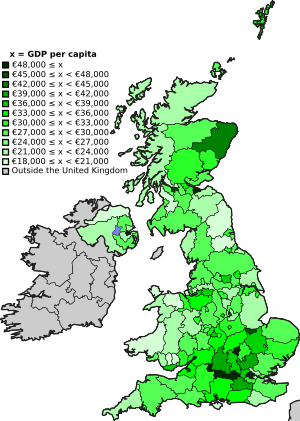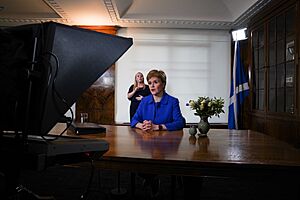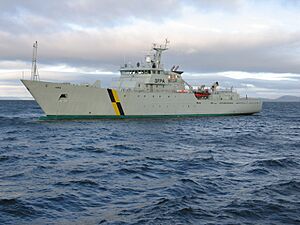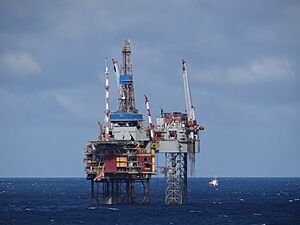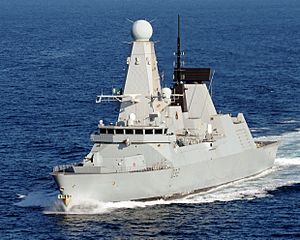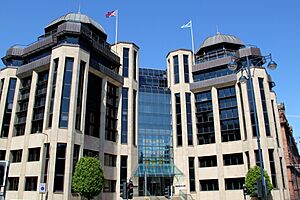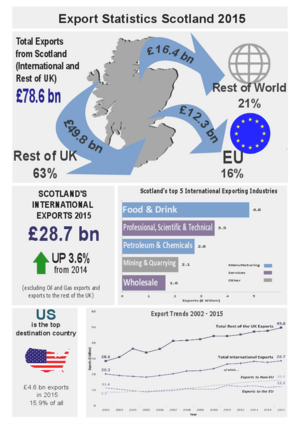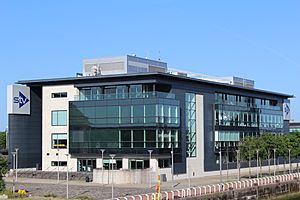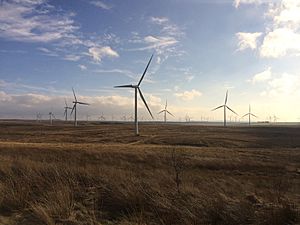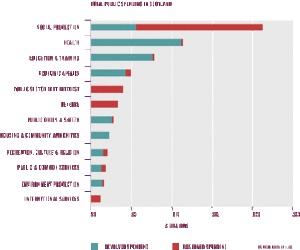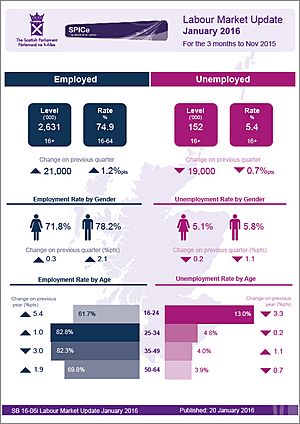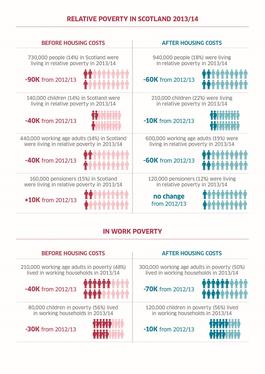Economy of Scotland facts for kids
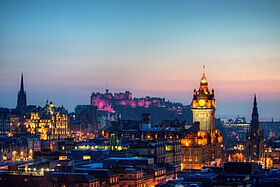
Edinburgh, the financial centre of Scotland
|
|
| Currency | Pound sterling (£) |
|---|---|
| 1 April to 31 March | |
| Statistics | |
| Population | 5,436,600 (2022) |
| GDP | £198.6 billion (onshore only, 2023) £218.0 billion (incl. oil and gas extraction, 2023) |
|
GDP per capita
|
£36,175 (onshore only, 2023) £39,707 (incl. oil and gas extraction, 2023) |
| 33 (2020–2023) | |
|
Labour force
|
2,613,000 / 73.1% in employment (Jan–Mar 2024) |
|
Labour force by occupation
|
List
27.0% Professional
16.5% Associate professional 9.7% Elementary occupations 9.4% Skilled trades 9.2% Administrative and secretarial 8.5% Caring, leisure and other service 7.7% Managers, directors and senior officials 6.8% Sales and customer service 4.8% Process plant and machine operatives (Jan–Dec 2023) |
| Unemployment | 120,000 / 4.4% (Jan–Mar 2024) |
|
Average gross salary
|
£702.40 per week (2023) |
| External | |
| Exports | £50.1 billion (2021) |
|
Export goods
|
List
£9.3bn Mineral fuels
£6.1bn Machinery and transport £4.2bn Beverages and tobacco £3.0bn Chemicals £2.4bn Manufactured goods £1.7bn Miscellaneous manufactures £1.7bn Food and live animals £0.6bn Crude materials £0.0bn Animal and vegetable oils £0.0bn Other commodities £28.9bn Total (2021) |
|
Main export partners
|
List
£16.4bn European Union
£4.4bn Asia & Oceania £3.8bn North America £1.4bn Western Europe (excl. EU) £1.2bn Middle East and North Africa (excl. EU) £0.7bn Latin America and Caribbean £0.6bn Sub-Saharan Africa £0.5bn Eastern Europe (excl. EU) £0.0bn Undefined country group £28.9bn Total (2021) |
| Imports | £29.2 billion (2021) |
|
Import goods
|
List
£7.8bn Machinery and transport
£6.3bn Mineral fuels £2.8bn Manufactured goods £2.5bn Miscellaneous manufactures £2.4bn Chemicals £1.7bn Food and live animals £0.8bn Crude materials £0.6bn Beverages and tobacco £0.1bn Animal and vegetable oils £0.0bn Other commodities £24.9bn Total (2021) |
|
Main import partners
|
List
£7.8bn European Union
£6.7bn Western Europe (excl. EU) £5.7bn Asia & Oceania £3.1bn North America £0.5bn Eastern Europe (excl. EU) £0.4bn Middle East and North Africa (excl. EU) £0.4bn Latin America and Caribbean £0.3bn Sub-Saharan Africa — Undefined country group £24.9bn Total (2021) |
The economy of Scotland is a system where goods and services are produced, bought, and sold. It is an open and mixed economy, meaning it trades a lot with other countries and has both private businesses and government involvement. Scotland's economy is the second largest among the countries of the United Kingdom.
In 2023, Scotland's total economic output, called gross domestic product (GDP), was about £218.0 billion. This figure includes money from oil and gas found off Scotland's coast. Since 1707, Scotland's economy has been closely linked to the rest of the United Kingdom (UK). Most of Scotland's trade happens within the UK.
Scotland was once a major industrial hub in Europe, known for manufacturing. Today, it produces many different things, from whisky and shortbread to computer software and financial services. Like many modern countries, Scotland has seen its manufacturing and mining industries shrink. Instead, the service sector (like banking, tourism, and healthcare) has grown to be the biggest part of its economy.
The UK Government and the Scottish Government both play a role in Scotland's economy. The Bank of England acts as Scotland's central bank, setting interest rates. Scotland uses the Pound sterling, which is one of the world's most important currencies. As part of the UK, Scotland is also a member of big international groups like the International Monetary Fund and the World Trade Organization.
Contents
Understanding Scotland's Economy
How Scotland's Economy Works
After the Industrial Revolution in Scotland, Scotland's economy focused on heavy industries like shipbuilding, coal mining, and steel. Being part of the British Empire helped Scotland sell its products worldwide. However, these heavy industries declined in the late 20th century.
This led to a shift towards technology and services. In the 1980s, an area called Silicon Glen (between Edinburgh and Glasgow) saw a boom in technology, with many big tech companies moving there.
In 2023, there were nearly 150,000 businesses in Scotland, employing 2.46 million people. The biggest job areas were health and social work, business services, and wholesale and retail.
Scottish companies are strong in information systems, defense, electronics, and semiconductors. There's also a growing electronics design industry, linked to universities. Other key industries include banking, construction, education, and tourism.
Edinburgh is Scotland's financial center. Glasgow is the UK's fourth-largest manufacturing hub. Aberdeen is the main city for North Sea oil and gas production.
A Look at Scotland's Economic Past
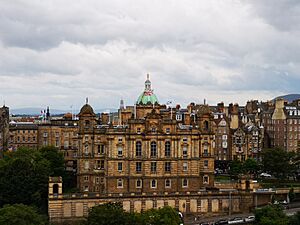
When Scotland joined with England in 1707, Scotland had no national debt. England, however, had a large debt. The agreement included a payment to Scotland, known as The Equivalent, to help with this.
The union initially cut off Scotland's trade links with countries like France. It took time for Scottish traders to join the colonial markets that English merchants had long controlled. Despite some early challenges, the union eventually gave Scotland access to England's global trade, leading to economic growth.
From 1790, textiles, especially cotton, became a major industry in western Scotland. This industry thrived until the American Civil War in 1861 cut off cotton supplies. By then, Scotland had developed heavy industries using its coal and iron. New inventions, like the hot blast for iron smelting, boosted the iron industry. Scotland became a leader in engineering, shipbuilding, and making locomotives.
Shipbuilding reached its peak in the early 1900s, especially during World War I. But it declined sharply after the war. Other countries started industrializing, so they no longer needed Scottish products. The period between the world wars was tough, with a major economic downturn.
The economy improved during World War II due to making war supplies. After 1945, older heavy industries continued to decline. The government encouraged new industries like atomic power and light engineering. This helped Scotland's economy become more diverse and stable.
How COVID-19 Affected Scotland's Economy
Like other countries, Scotland's economy lost money when businesses had to close during the national lockdown in March 2020. The Scottish Government expected unemployment to rise. Many industries operated at a slower pace to stop the virus from spreading.
The tourism and hospitality industries were hit especially hard. In 2020, the Scottish Tourism Alliance said that recovery would be very difficult without continued government support. The First Minister, Nicola Sturgeon, also recognized these challenges.
Some people suggested that the economic impact of COVID-19 could have long-lasting effects on Scotland's economy. This is similar to how the decline of shipyards and coal mining in the 1980s changed the economy.
Exports of food and drink, including Scotch whisky, dropped significantly. Distilleries had to close, and the global hospitality industry suffered. By February 2021, the Scotch whisky sector had lost £1.1 billion in sales. Exports to the US also fell due to tariffs.
Key Industries in Scotland
Farming and Forests
Only a small part of Scotland's land, about 10%, is used for growing crops. Barley, wheat, and potatoes are grown in eastern areas like Aberdeenshire and Fife. The Tayside and Angus area is known for soft fruits like strawberries and raspberries.
Raising sheep is important in the mountainous regions, where the land is less suitable for crops. Dairy farming is common in the southwest, like Ayrshire. Scottish farms are very modern and efficient.
Most land in Scotland is owned by a small number of people. In 2003, a new law was passed to allow tenant farmers and communities to buy land.
About 18.5% of Scotland is covered by forests. Most forests are publicly owned and managed by Scottish Forestry. The biggest forests are in Dumfries and Galloway and the Scottish Highlands. Forestry creates jobs in planting, harvesting, and making wood products like paper. Forests also offer places for recreation.
Fishing Industry
The waters around Scotland are rich in fish. Fishing is a main industry in parts of the North East and along the west coast. Important fish markets are in places like Aberdeen and Mallaig. Fish like herring, crab, lobster, haddock, and cod are brought to ports such as Peterhead (Europe's biggest white fish port) and Fraserburgh (Europe's biggest shellfish port).
However, the number of jobs in fishing has decreased. This is partly due to rules on how much fish can be caught to help fish stocks recover.
As sea fishing has declined, fish farms, especially for salmon, have become more important in Scotland's rivers and lochs.
Natural Resources: Oil and Gas
Scotland has many natural resources, including fertile land and oil and gas. It also has coal, zinc, and iron. Coal mining was once a big employer in central Scotland, but it has declined. The last deep coal mine closed in 2016.
Scottish waters in the North Sea have some of the largest oil resources in Western Europe. The discovery of North Sea oil changed Scotland's economy. Oil was found in 1966, and full production began in 1976.
The city of Aberdeen became the center of the North Sea Oil Industry. Major oil terminals are located at Sullom Voe in Shetland and Flotta in Orkney. Grangemouth is a hub for Scotland's petrochemical industry. These oil-related industries provide many jobs and income.
Although North Sea oil production has been going down since 1999, there is still a lot of oil left. High oil prices have led to new oil exploration, especially west of Shetland. The North Sea oil and gas industry contributed £35 billion to the UK economy in 2014.
Manufacturing and Production
From Heavy to Light Industry
Scotland's heavy industries, like shipbuilding and iron and steel, grew in the late 1700s. The Carron Company started its ironworks in 1759. Shipbuilding on the River Clyde grew rapidly from the 1840s. By 1870, the Clyde was building more than half of Britain's ships.
However, these heavy industries declined sharply after World War II. This was partly due to increased globalisation and competition from other countries.
Now, Scotland focuses on lighter manufacturing, such as optoelectronics, software, and chemical products. The engineering and defense sectors employ about 30,000 people. Companies like BAE Systems and Rolls-Royce operate here.
Scottish Aviation made successful aircraft like the Handley Page Jetstream. This company is now part of BAE Systems and is based in Prestwick. By the end of World War II, Scotland's aviation industry employed over 30,000 people. Today, the aviation sector in Scotland focuses on manufacturing, repair, and avionics.
Scotland's Famous Whisky
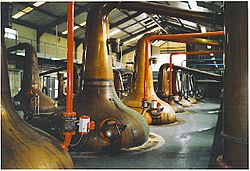
Whisky is perhaps Scotland's most famous product. Exports of whisky have grown a lot, contributing over £4.25 billion to the UK economy. It is one of the UK's top five manufactured exports and supports about 35,000 jobs.
Major whisky-producing areas include Speyside and the Isle of Islay, where distilleries provide many jobs. The whisky industry is also closely linked to tourism, with many distilleries offering tours.
Textiles and Clothing
Historically, Scotland traded animal hides and wool. This trade grew, especially with countries in the Low Countries and the Baltic.
In the 18th century, linen production became very important, with over 12 million yards produced in 1775. By 1770, Glasgow was Britain's largest linen manufacturer.
Cotton began to replace linen in the 1770s. The first cotton mill opened in Penicuik in 1778. This industry led to more people moving to cities, including many from the Highlands and Ireland.
Today, knitwear and tweed are seen as traditional crafts. However, brands like Pringle and Lyle & Scott have made Scottish clothing famous worldwide. Despite competition from other countries, the textile industry in Scotland still employs about 22,000 people. It is Scotland's seventh-largest exporter of manufactured goods.
Electronics and Tech

Silicon Glen is a term used to describe the growth of Scotland's high-tech and electronics industries in the Central Belt during the 1980s and 1990s. This area was similar to Silicon Valley in California.
Companies like IBM and Hewlett-Packard have been in Scotland since the 1950s. Today, about 45,000 people work in electronics and related fields. In 2006, Scotland produced a large percentage of Europe's PCs and notebooks.
Two major video game developers are based in Scotland: Rockstar North, known for Grand Theft Auto, and Rockstar Dundee.
Building and Construction
Scotland builds around 21,000 to 22,000 new homes each year. In 2018, over 20,000 new homes were built, the highest number in a decade.
The home building industry contributes about £5 billion to Scotland's economy, which is about 2% of its GDP. This is more than some other well-known industries like agriculture or tourism. The total value of new building and repairs is nearly £11.6 billion, about 4.5% of Scotland's GDP.
Service Industries
Financial Services
Edinburgh is a significant global financial center. Large financial companies like The Royal Bank of Scotland, the Bank of Scotland, Scottish Widows, and Standard Life have offices there.
The financial services industry, mainly in Edinburgh and Glasgow, grew by over 35% between 2000 and 2005. It employs about 95,000 people and generates £7 billion, or 7% of Scotland's GDP. By 2020, Edinburgh was ranked the 13th largest financial center in the world.
Banking in Scotland
Banking in Scotland has a long history. The Bank of Scotland was created in Edinburgh in 1695. It was the first bank in Europe to successfully print its own banknotes. It is one of the oldest banks in the world still operating.
Scotland has four main banks: the Bank of Scotland, The Royal Bank of Scotland, the Clydesdale Bank, and TSB Bank. The Royal Bank of Scotland grew to be one of the largest banks in Europe.
Even though the Bank of England is the central bank for the UK, three Scottish banks still print their own banknotes. These notes are accepted throughout Scotland and by some shops in the rest of the UK.
Investment and Insurance
Many life assurance (insurance) companies were created in Scotland in the early 1800s. Today, Scotland is one of the world's biggest centers for managing money funds, with over £300 billion worth of assets. Scottish fund managers specialize in pensions, property funds, and investment trusts.
Software Development
The software sector in Scotland has grown quickly. In 2016, over 40,000 people worked in the digital economy in Edinburgh, Glasgow, and Dundee. Scotland's history in manufacturing is now helping its software industry, attracting companies from around the world.
Companies like Skyscanner, FanDuel, and Amazon have software development in Scotland. Universities, like the University of Edinburgh's School of Informatics, play a big role by doing research in computer science.
Tourism in Scotland
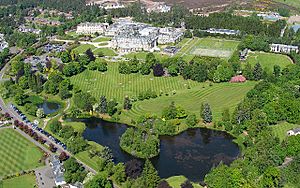
Tourism makes up about 5% of Scotland's GDP. Scotland is a popular place to visit, with beautiful countryside, mountains, and rich history. The tourism industry supports about 196,000 jobs in Scotland.
In 2014, over 15.5 million overnight trips were made in Scotland, bringing in £4.8 billion. Most visitors come from other parts of the United Kingdom. International visitors mainly come from the United States, Germany, and France.
The COVID-19 pandemic negatively impacted tourism in Scotland. Many businesses reported lower income. In March 2021, the First Minister announced a £25 million program to help the tourism industry recover.
Trade and Connections
Trading with Other Countries
Outside of the UK, the European Union and the United States are the biggest markets for Scotland's exports. In recent years, Scotland has also focused on selling products to fast-growing economies in Southeast Asia, like China and Singapore.
In 2014, the total value of international exports from Scotland (not including oil and gas) was about £27.5 billion. The top exporting industries were food and drink, legal and accounting services, and refined petroleum products. Exports to the rest of the UK were estimated at £48.5 billion.
Overall, Scotland, like the rest of the UK, imports more than it exports. In 2020, Scotland's exports were worth £78.4 billion, while imports were £90.6 billion.
Scotland's Transport System
Airports and Ports

Scotland's main airports include Edinburgh Airport, Glasgow International Airport, and Aberdeen Airport. Most airports were privatized in the 1980s. In 2004, over 22 million passengers used Scotland's airports. There are plans to expand capacity at major airports to handle more passengers. Prestwick Airport also handles a lot of air cargo. Scotland has a growing network of international flights.
Scotland also has several seaports, such as Clydeport, Grangemouth, and Port of Aberdeen. These ports are important for trade. Many island communities rely on ferry services, which are vital for bringing in goods and tourists, and exporting local products.
Roads and Railways
Scotland has a network of important roads called trunk roads. These roads connect major cities, ports, and islands. They are kept to a high standard and are crucial for the economy. Key routes include the M8 between Edinburgh and Glasgow, and the A9 connecting the Highlands to the central area.
The railway networks in Scotland were built in the Victorian era, mainly for moving goods like coal. Many local railway services were closed in the 1960s because people started using buses and cars more. Today, most train services are for passengers, operated by ScotRail. There are also overnight sleeper services to London.
Local Transportation
Local roads are maintained by Councils. Bus services are run by private companies. The SPT operates the Glasgow Subway, a circular underground railway. Edinburgh Trams is the only light railway in Scotland. In some rural areas, roads are single-track with passing places, where drivers must pull over to let oncoming vehicles pass.
Communication Networks
Scotland has modern communication systems, similar to other Western countries. It has extensive radio, television, landline, mobile phone, and broadband internet networks. The most populated areas, like the Central Belt, Aberdeen, Dundee, and Inverness, have good 4G mobile connections.
BBC Scotland is Scotland's main public broadcaster, with many TV and radio stations. There are also private commercial TV and radio broadcasters.
Energy Production
Energy policy in Scotland is mainly decided by the UK government. However, the Scottish Parliament can influence it, for example, by encouraging wind turbine construction.
Scotland has excellent renewable energy resources. A large amount of its electricity comes from wind, hydroelectric, and nuclear sources. In 2020, over 90% of Scotland's electricity was generated from renewable sources, mainly onshore wind. There are many wind farms, with plans for even larger ones.
In 2022, Scotland exported a lot of its electricity, worth £4 billion.
Gas infrastructure in Scotland is managed by SGN. The UK is no longer self-sufficient in natural gas from the North Sea. Gas is used for cooking and heating in many homes. The Scottish Government plans to use hydrogen instead of natural gas by 2030, produced from renewable energy or with carbon capture and storage.
Government and Economy
Taxation and Public Money
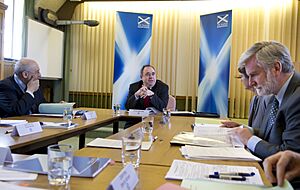
Most taxes paid by Scottish residents and businesses are collected by the UK government. However, since 2012 and 2016, the Scottish Parliament has gained more power over certain taxes. For example, Scotland started collecting its own landfill tax and property transaction taxes from 2015-16.
In 2015-16, the total public income in Scotland (not including North Sea oil) was about £53.7 billion. Total public spending in Scotland was estimated to be £68.6 billion.
Jobs and Businesses
As of March 2016, there were over 348,000 Small and Medium-sized Enterprises (SMEs) in Scotland. These businesses provided about 1.2 million jobs. SMEs made up almost all private sector businesses (99.3%) and accounted for over half of private sector jobs.
The Public Sector's Role
The public sector in Scotland, which includes government departments, local councils, and public organizations, has a big impact on the economy. In 2016, about 545,000 people worked in the public sector. This includes doctors and nurses in the National Health Service, police officers, and teachers.
After a vote in 1997, the Scottish Parliament was re-established. It can make laws on many issues that are not "reserved" for the UK Parliament. This means there is a clear division of responsibilities between the UK and Scottish governments regarding economic policy.
Economic Performance Across Scotland
The economic output per person (GDP per capita) varies across Scotland. For example, it ranges from €16,200 in North & East Ayrshire to €50,400 in Edinburgh city. Some areas have lower GDP per person, indicating less economic activity.
Here's a look at the economic position of different Scottish regions in 2013, based on GDP and GDP per person (excluding offshore oil revenue):
| Area | Total € |
Per capita € |
|---|---|---|
| Tayside | €13 bn | €25,950 |
| Angus & Dundee | €6.5 bn | €24,500 |
| Perth & Kinross & Stirling | €6.5 bn | €27,400 |
| Dumfries & Galloway | €3 bn | €20,500 |
| Scottish Borders | €2.3 bn | €20,300 |
| Clackmann. & Fife | €8.3 bn | €19,900 |
| Falkirk | €3.4 bn | €21,800 |
| Edinburgh & Lothian | €32.7 bn | €31,766 |
| Edinburgh | €24.6 bn | €50,400 |
| West Lothian | €4.6 bn | €26,200 |
| East & Mid Lothian | €3.5 bn | €18,700 |
| Glasgow & Strathclyde | €57.6 bn | €23,671 |
| Glasgow City | €25.5 bn | €42,700 |
| Inverclyde & East Renfrew & Renfrew | €7.3 bn | €21,000 |
| North Lanarkshire | €7.1 bn | €21,200 |
| South Ayrshire | €2.9 bn | €25,200 |
| South Lanarkshire | €6.7 bn | €21,500 |
| East & West Dumbarton | €4 bn | €17,900 |
| East & North Ayrshire | €4.1 bn | €16,200 |
| Grampian | €23.2 bn | €47,900 |
| Aberdeen & Aberdeensire | €23.2 bn | €47,900 |
| Highlands & Islands | €11.2 bn | €24,000 |
| Caithness & Sutherland & Ross & Cromarty | €1.7 bn | €18,400 |
| Inverness | €5.3 bn | €26,900 |
| Lochaber & Skye | €2.3 bn | €23,300 |
| Eilean Siar | €0.5 bn | €20,200 |
| Orkney | €0.5 bn | €23,600 |
| Shetland | €1.1 bn | €45,800 |
| Total | €154.9 bn | €29,100 (excl. oil revenue) |
Images for kids
-
Shipbuilding on the River Clyde in Glasgow produced ships like the RMS Queen Mary.


